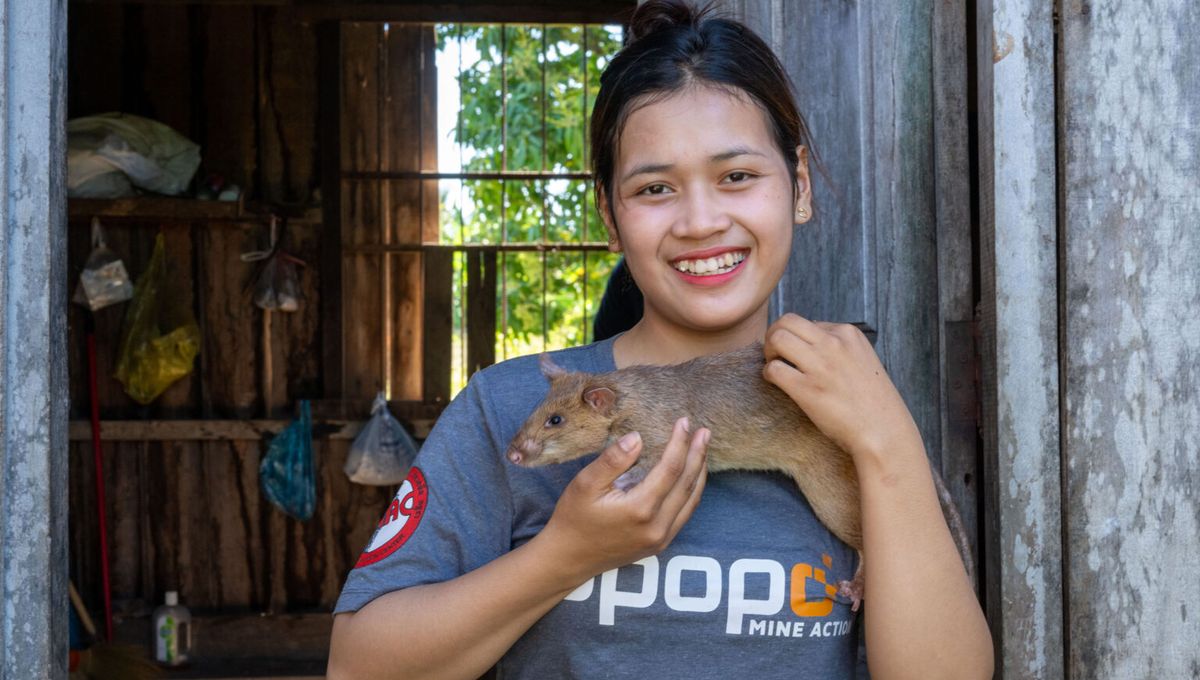
Times are tough at the moment and world news may feel like we are bouncing from one negative story to another, so here’s something to add some pep to our news consumption step. Anti-Personnel Landmines Detection Product Development (APOPO), a Belgian non-governmental organization, has just announced that HeroRAT Ronin has broken the Guinness World Record for the most landmines detected by a rat.
The achievement is nothing to squeak at, as this rodent of unusual size, an African giant pouched rat (Cricetomys ansorgei), is basically helping to save lives. Ronin and his fellow rats are aiding ongoing efforts to detect and clear some of the 4 to 6 million landmines and other unexploded munitions that lie hidden in Cambodia after years of conflict.
Since 1979, these hidden explosives have killed around 20,000 people and seriously injured 45,000 more. Although demining efforts are having an impact, reducing casualties to 32 reported incidents in 2023, the risks are still there.
This is where APOPO come in. For over 25 years, they have been training African giant pouched rats – their “HeroRATS” – to detect landmines in locations like Cambodia. It’s an important innovation, as they’ve helped to clear millions of square meters of land across the world, making it safe for communities who would otherwise be surrounded by threats buried in the ground.
Since his deployment to Preah Vihear Province, Cambodia in August 2021, Ronin has detected an incredible 109 landmines and 15 items of unexploded ordnance (UXO). This act surpasses the previous record holder, Magawa, who identified 71 landmines and 38 UXOs during his five-year service.
Ronin, equipped with his adorable harness and lead, is just getting started. He is only 5 years old, so he may have another two or more years of detection work to go before his career ends.
Obviously dealing with a minefield is a bit of a… minefield, so rats like Ronin are meticulously trained, but APOPO stress that it is all done through positive reinforcement. Born and raised in Morogoro, Tanzania, at APOPO’s Training Centre at Sokoine University of Agriculture, Ronin was soon introduced to clicker training, where he learnt to associate the sound of the clicks with treats, such as bananas and peanuts. It is the motivation of this reward-based system that encourages him and his ratty colleagues to sniff out explosives.
HeroRATS are trained to work systematically within a grid pattern where they are attached to a line. When they find a suspected mine, they start to scratch at the ground.
The rats only work 30 minutes a day, in the cool early hours of the morning so that they don’t have to suffer in the heat. This means they can spend the rest of their time resting, playing, or exploring. According to a statement from APOPO, the rats’ work is “considered an enrichment activity that keeps their minds and noses stimulated”, though it is not clear whether this is a statement made by a person or one of the rats.
African giant pouched rats tend to live for around eight years, maybe a little more. So when they start to show signs of slowing down or become less interested in their work, they’re retired to APOPO’s retirement colony, where they “live out their golden years in comfort.”
“Our HeroRATs are not just workers; they are cherished members of our team. Ensuring their well-being, both during and after their working lives, is our absolute priority,” Pendo Msegu, APOPO Animal Welfare Officer, Tanzania, explained.
Across the world, there are estimated to be over 110 million landmines still buried in more than 60 countries. According to the Mine Action Review, in 2023, there were 1,431 deaths and 5,241 recorded casualties from landmines and other explosive remnants of war. Most victims were civilians, with children representing almost half of the casualties.
“When we launched APOPO, the common view was that it would take around 500 years to clear all landmines from the Earth’s surface,” Christophe Cox, APOPO’s CEO, explained. “Twenty-five years later, there is light at the end of the tunnel, and if the international community fully supports the collaboration of all demining operators, we could clear the remaining minefields in our lifetime”.
Source Link: Meet Ronin, The Guinness World Record-Breaking Rat Who's Saving Lives, One Mine At A Time